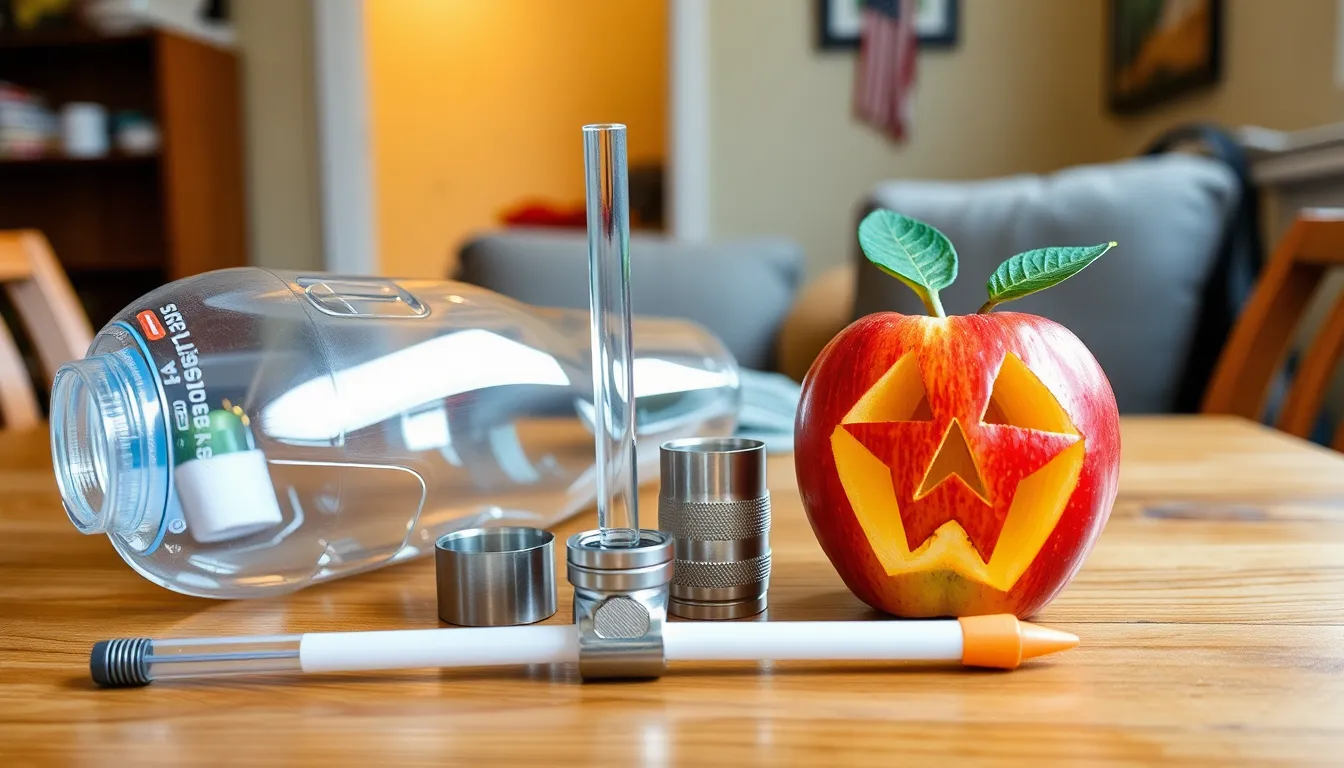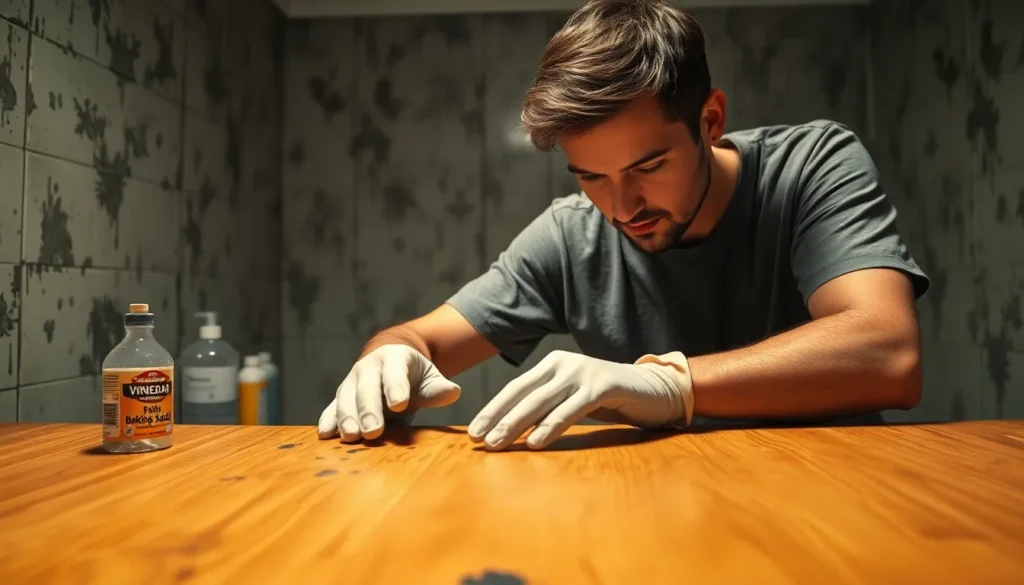Table of Contents
ToggleWhen the desire to unwind strikes but the nearest bong is nowhere in sight, creativity becomes the ultimate tool. Who needs foil when you can craft a homemade masterpiece from everyday items? Not only does this approach keep the vibes high, but it also adds a dash of DIY flair to your smoking experience.
Understanding the Basics of Bongs
Bongs serve as devices designed for smoking substances like cannabis. Their advantages include enhanced filtration and cooling of smoke, which leads to smoother inhalation. Various parts comprise a bong, including the bowl, downstem, and chamber. The bowl holds the plant material, while the downstem extends into the water chamber, where smoke passes through before reaching the user.
Water plays a crucial role in filtration. It traps impurities and cools the smoke, making for a more enjoyable experience. Many individuals prefer percolators, which are additional filtration systems in some bongs. These systems enhance the cooling process further, promoting a smoother draw.
Materials used in bong construction vary widely. Glass, plastic, and ceramic are common choices, with each material offering distinct aesthetics and durability. Glass bongs, though more fragile, often deliver cleaner taste experiences. Alternative materials like plastic provide greater durability but may alter the flavor of the smoke.
Various designs exist, each accommodating different smoking preferences. Straight-tube bongs feature a simple, classic structure. Beaker bongs, with their wider base, offer greater stability. Unique designs incorporate additional features like ice catchers, enabling users to add ice cubes for a cooler hit.
Understanding how bongs function promotes better smoking practices. Learning about airflow dynamics and proper cleaning techniques ensures optimal experiences. Cleaning keeps the device functioning well, as residue buildup can affect flavor and efficiency. Regular maintenance contributes to a healthier smoking experience.
Materials Needed

Creating a homemade bong can be done with materials commonly found around the house. These items help craft a functional smoking device without relying on foil.
Common Household Items
Bottles act as excellent bases for DIY bongs. A plastic or glass bottle provides the necessary structure and stability. Straws can function as downstems, allowing smoke to travel through water. Additionally, a bowl can be fashioned from various objects like a metal socket or even a small piece of apple. Using these ordinary items offers a creative solution while ensuring the smoking experience remains enjoyable. Even scissors help with cutting materials to the desired size.
Alternative Options
Some alternatives enhance the brainstorming process. Empty soda cans serve as easy-to-make options; simply puncture holes for airflow and smoke management. PVC pipes can also be utilized, providing a more durable structure. For those seeking a more unique touch, fruits such as pineapples or pumpkins may create bong shapes while adding flavor. Innovating with items not typically associated with smoking devices allows for a fun and personalized experience. Exploring these alternative options fosters creativity in the DIY process.
Step-by-Step Guide
Creating a homemade bong can be an easy and fun process. Follow these simple steps to get started on crafting your own device without using foil.
Preparing the Base
Select a suitable bottle for the base. A plastic or glass bottle that holds water works best. Cut a small hole near the bottom for the downstem, ensuring it creates a tight seal. Fill the bottle with water, leaving enough space above to prevent overflow. The water cools the smoke and traps impurities, making the experience smoother.
Creating the Bowl
Use a small object as the bowl component. An empty pen casing or a metal socket from a hardware store can serve this purpose. Create a small hole to allow airflow, ensuring it fits snugly into the downstem. The bowl should be deep enough to hold your desired smoking material. Make sure the bowl’s design accommodates proper burning and airflow for an optimal experience.
Assembling the Bong
Insert the downstem into the hole in the bottle. Ensure the fit is tight to prevent any air leaks. Attach the bowl securely to the end of the downstem. Test the completed structure to confirm that all components are functional and airtight. Adjust any connections if necessary for the best results. Enjoy your homemade bong, taking care to use it responsibly.
Tips for Enhancing Your Experience
Try experimenting with different bowl materials. Small items like metal parts from pens or even pieces of fruit provide unique flavors and aromas during inhalation.
Consider the water level in the bong. Maintaining the right water depth ensures optimal filtration and cooling, enhancing the overall smoking experience.
Add ice to the chamber for a smoother hit. Ice cubes chill the smoke further, making inhalation more comfortable and enjoyable.
Use flavored water for additional benefits. Infused liquids like herbal teas or juices add a subtle flavor to the smoke.
Explore various packing techniques for the bowl. Loose packing creates airflow, while tight packing enhances flavor and intensity.
Keep the bong clean for an improved experience. Regular cleaning prevents residue buildup and maintains the integrity of flavors.
Experiment with different smoking techniques. Utilizing slow, steady inhalation allows for maximum filtration and enjoyment.
Engage with friends in a relaxed setting. Sharing the experience with others fosters a social atmosphere, making each session more enjoyable.
Focus on finding the right strain. Selecting a strain that suits personal preferences enhances effects and enjoyment.
Incorporate accessories like percolators for additional filtration. These components improve smoothness and overall quality of the smoke, leading to a better experience.
Safety Considerations
Safety remains a top priority when crafting homemade bongs. Always use clean materials to avoid inhaling harmful substances. Glass and metal components are preferable due to their heat resistance.
Avoid using plastic items that can release toxins when heated. Responsible preparation of materials ensures a safer smoking experience. Testing the stability of the bong before use prevents spills and possible injuries.
Always ensure a proper water level in the bong. Incorrect water levels can lead to overheating and reduced filtration, which may negatively impact comfort. Use only substances that are legal and considered safe for inhalation.
Consider the environment when smoking. Proper ventilation reduces the build-up of smoke, making it safer and more comfortable. Additionally, be mindful of the surrounding individuals to avoid secondhand smoke exposure.
Practice good hygiene with all homemade devices. Regular cleaning of the bong minimizes residue buildup, promoting a healthier smoking session.
Lastly, know personal limits regarding dosage and frequency. Recognizing how substances affect one’s body helps prevent overconsumption and adverse reactions. Implementing these safety measures leads to a more enjoyable and responsible experience.
Creating a homemade bong without foil opens up a world of possibilities for smokers seeking a unique experience. By utilizing everyday items and embracing creativity, individuals can craft functional devices that enhance their enjoyment.
The versatility in materials and designs allows for personalization while ensuring a smooth smoking session. Prioritizing safety and hygiene remains essential throughout the process.
With the right techniques and a focus on innovation, anyone can enjoy a satisfying and responsible smoking experience. Engaging with friends and experimenting with different methods can further elevate the enjoyment, making each session memorable and tailored to personal preferences.










